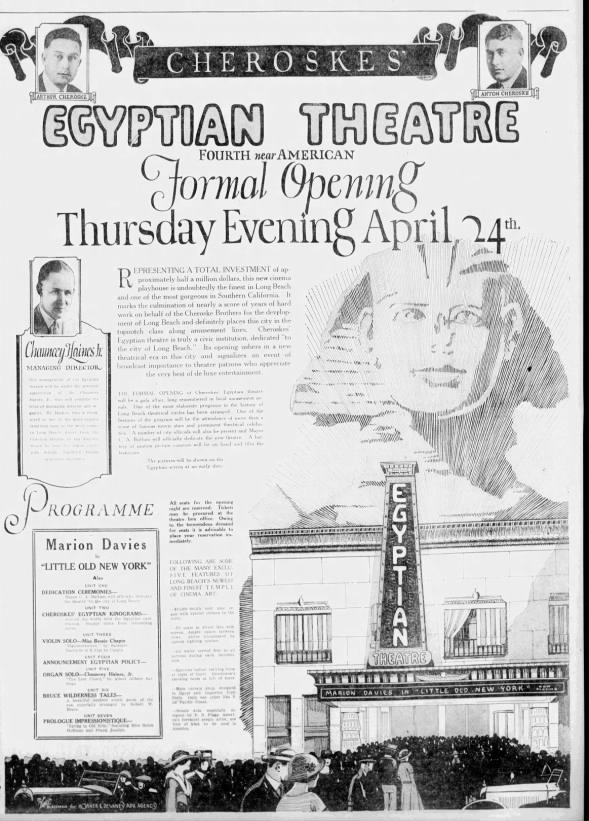
Egyptian Theatre
234 E. 4th Street,
Long Beach,
CA
90802
![]() 3 people
favorited this theater
3 people
favorited this theater
Additional Info
Previously operated by: Fox West Coast Theatres
Architects: Edward S. Baume, Hugh R. Davies, Fred J. Ward
Styles: Egyptian, Streamline Moderne
Previous Names: Cheroske's Egyptian Theatre, Fox Egyptian Theatre
Nearby Theaters
Built for and operated by the Cheroske’s Brothers (Arthur & Anton), their Egyptian Theatre was opened on April 24, 1924 with Marion Davis in “Little Old New York”. It was designed by architect Fred J. Ward. It was equipped with a 2 manual Smith organ which was opened by Chaunsey Haines Jr. who was also one of the managing directors of the operating company. The organ has ‘special chimes in the lobby’. The main curtain drop was made in Egypt and imported from Paris. There was only one other like it on the Pacific Coast. In 1925 the Egyptian Theatre became a West Coast Theatres house.
It was closed on January 28, 1959 with Kirk Douglas in “Last Train from Gun Hill” & Anton Diffring in “The Man Who Could Cheat Death”. It was demolished in October 1959.
Just login to your account and subscribe to this theater.

Recent comments (view all 19 comments)
Wow! The photo in the previous posting by ken mc is something I’ve never seen before! Looks like it might even be a private screening room from some palatial estate. If it’s really a public movie theatre, is has to be a nickelodeon that was given an Egyptian remodeling. You’ll notice that most of the plasterwork is Renaissance in style. The Egyptian detailing is confined to cavetto moldings in the bays closest to the screen, along with a sunburst ceiling ornament like Grauman’s Egyptian has (and was then copied in many Egyptian style theatres from Boise to Ogden to Oakland). Some Egyptian cavetto moldings can also be seen along the top of the walls closest to the viewer. So, either this is a little theatre which went through a remodel, or someone changed the design direction during construction.
Aha! Closer examination reveals another possibility for this photo (ken mc’s post of Sept. 7th). I notice that each bay between the pilasters as you go down the sidewalls is done in a completely different ornamental style. Not only that, but each ceiling section has a different ornamental plaster design. I think what we have here is a photo of a “display” theatre for either a decorative plaster studio, a decorative painting studio, theatre architect, or all of the above. It’s like a “sampler” of theatre design. This sort of thing was done for tradeshows for theatre seat companies, box office designs, and later on, concession stand designs. Certainly designers and decorators themselves would have wanted to do the same.
I counted the seats as best as I could (hard to do in the front rows) and the seating capacity is under 200.
According to the June 8, 1923 issue of Southwest Builder & Contractor, the Egyptian Theatre was remodeled from an existing building which had been a garage. The conversion was designed by Long Beach architects Hugh R. Davies and Edward S. Baume, associated.
In 1936, S. Charles Lee prepared this concept rendering for a facade remodeling of the theatre, which appears not to have been carried out.
The S. Charles Lee rendering in Joe Vogel’s immediate preceeding post is of a proposed remodel of the entrance of the Egyptian in Hollywood. You can even see the facade and marquee of the Pig & Whistle to the right of it—a facade which still exists today.
To bad Fox West Coast Theatres did not do the proposed remodel of the Egyptian Theatre’s facade in Hollywood.
The photo of the Egyptian-styled theater that kenmcintyre linked to earlier has gone missing. This is its current location, but the California State Library doesn’t provide permalinks so it will probably vanish again. It turns out to be, as GaryParks surmised, a sort of architectural sampler. It was a model theater produced around 1915 by the Epco Theatre Supply Company (EPCO = Electrical Products Corporation, so it probably displayed something like theater lighting equipment.)
Gary is right about the S. Charles Lee drawing being for the Hollywood Egyptian. The drawing was mislabled by the S. C. Lee Collection as being a house in Long Beach. Lee probably had nothing to do with this theater, so only Baume and Davies should be credited as the architects.
Oh, and this house was listed as the Fox Egyptian Theatre, at 234 E. 4th Street, in the 1935 Long Beach city directory.
According to “The Encyclopedia of the American Theatre Organ” by David Junchen, the “Egyptian Theatre” in Long Beach originally had a two manual Smith theatre pipe organ installed in 1924. No other details, such as # of ranks (size of the actual organ), or blower info is given.
Does anybody know what happened to this organ, or its parts? Thanks!
The Egyptian theatre opened on April 24th, 1924. Egyptian theatre opening Wed, Apr 23, 1924 – 17 · Press-Telegram (Long Beach, California) · Newspapers.com
Egyptian theatre opening Wed, Apr 23, 1924 – 17 · Press-Telegram (Long Beach, California) · Newspapers.com
Antone F. Cheroske was the builder and owner of the Egyptian in 1924. Fred J. Ward was the architect. Cheroske sold to Fox West Coast Theatres Circuit. The Egyptian installed sound to stay relevant. The theatre closed on July 28, 1959 with “Last Train from Gun Hill” and “Man Who Could Cheat Death.” A sign reading, “Temporarily Closed” was posted on the attractor which remained until the Egyptian was razed in October of 1959.